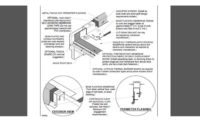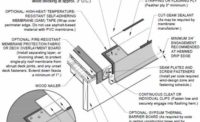
Edge flashing is the most critical component of a roof system, particularly in high-velocity wind regions. The majority of wind damage and roof blow-offs are initiated at the perimeter edge. Flashing application at these points should be compliant with ASCE requirements. It can also be beneficial to review FM Loss Prevention Data Sheet 1-49, Perimeter Flashing, for valuable design and application techniques at these vulnerable locations.
Perimeter edge flashing typically begins with some form of perimeter blocking system. The base blocking should be applied to the structural components - not the decking. The blocking system is required for securement of the metal edge coverings. The membrane is typically applied through to the edge of the blocking with the flashing applied from the fascia to 4 inches to 6 inches onto the membrane surface. Some single-ply systems do not require separate flashings.
Gravel stops - fabricated from heavy metal, such as aluminum extrusions, or fabricated from lighter metal, such as thin sheet metal - are applied at the perimeter edge. The gravel stops are fabricated to cover the face of the edge and out onto the membrane surface. Flashing application depends on the type of metal used. Heavy metal gravel stops are applied over the flashings and secured to the blocking system with appropriate fasteners at the rate required for the buildings wind zone. Heavy metal gravel stops require concealed cleats and expansion joints for expansion and contraction.
Separation of the metal and the membrane is required in lighter metal applications. Flashings are typically applied over the metal in these cases. Some thermoplastic manufacturers require a thermoplastic-coated metal gravel stop be applied with their systems. In these applications, the gravel stop is heat welded to the membrane.

